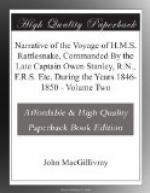(Footnote. A slender, branchless, cylindrical, articulated seaweed, of a very pale green colour, was pointed out to me by a native as being the favourite food of the dugong.)
Cooking in the oven.
This oven is of simple construction—a number of stones, the size of the fist, are laid on the ground, and a fire is continued above them until they are sufficiently hot, the meat is then laid upon the bottom layer with some of the heated stones above it, a rim of tea-tree bark banked up with sand or earth is put up all round, with a quantity of bark, leaves, or grass on top, to retain the steam, and the process of baking goes on. This is the favourite mode of cooking turtle and dugong throughout Torres Strait, and on the east coast of the mainland I have seen similar fireplaces as far south as Sandy Cape.
Culture of the yam.
A great variety of yam-like tubers are cultivated in Torres Strait. Although on Murray and Darnley and other thickly peopled and fertile islands a considerable extent of land in small patches has been brought under cultivation, at the Prince of Wales Islands the cleared spots are few in number, and of small extent—nor does the latter group naturally produce either the coconut or bamboo, or is the culture of the banana attempted. On the mainland again I never saw the slightest attempt at gardening.
The principal yam, or that known by the names of kutai and ketai, is the most important article of vegetable food, as it lasts nearly throughout the dry season. Forming a yam garden is a very simple operation. No fencing is required—the patch of ground is strewed with branches and wood, which when thoroughly dry are set on fire to clear the surface—the ground is loosely turned up with a sharpened stick, and the cut pieces of yam are planted at irregular intervals, each with a small pole for the plant to climb up. These operations are completed just before the commencement of the wet season, or in the month of October.




